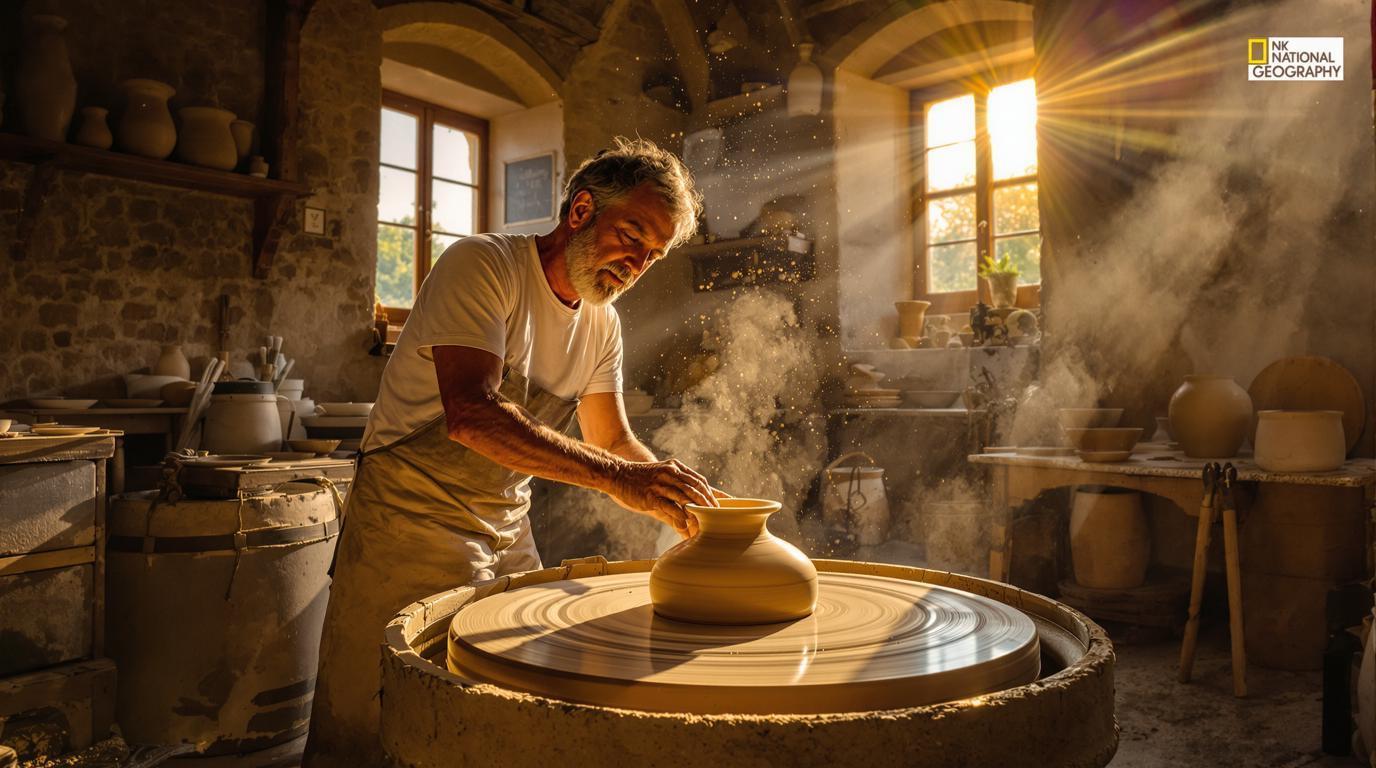The pottery wheel spun under my hands as morning light filtered through the stone workshop windows, and I knew I’d discovered something extraordinary. While tourists crowd the lavender fields of nearby Nyons, this 3,204-resident village in southeastern France quietly guards ceramic secrets that have been passed down through 400 years of unbroken tradition. Dieulefit sits at 386 meters elevation in the Drôme department, where local clay deposits create pottery unlike anywhere else in Provence.
The artisan beside me, his hands stained with generations of clay dust, smiled as he shaped what would become a traditional daubière pot. “The tourists who come here from Nyons, they don’t understand,” he whispered in accented English. “They think pottery is just decoration. But here, we make vessels that feed families.”
This discovery happened three summers ago when I was researching authentic French craft traditions away from the tourist circuits. What I found in Dieulefit changed my understanding of what authentic artisanal heritage really means.
The 400-Year Clay Secret That Rivals Tuscany’s Famous Ceramics
Why Dieulefit’s Clay Creates Pottery Unlike Any Other Region
The secret lies beneath your feet in this 27.42 square kilometer commune. Local clay deposits, formed over millennia by the unique geological conditions of the Drôme valley, contain mineral compositions that create pottery with exceptional durability and distinctive earth tones. Unlike the tourist-focused ceramic shops of Vallauris or Moustiers-Sainte-Marie, Dieulefit’s workshops still extract clay from the same quarries their ancestors used four centuries ago.
The Workshop Masters Who Refuse Tourist Crowds
Seven working ateliers operate in the village center, each maintaining techniques that predate the French Revolution. Master potter Jacques Pouchain’s workshop, established in 1950, continues traditions passed down through family lines. His apprentices learn the ancient firing methods that create Dieulefit’s signature glazes, techniques so specific to local materials that they cannot be replicated elsewhere.
Hidden Authenticity That Defies Mass Tourism
The Village That Chose Craft Over Commerce
While Montbrun-les-Bains attracts spa tourists and Nyons draws olive oil enthusiasts, Dieulefit deliberately maintains its artisan character. The village holds “Tourist Resort” status since 1928, yet operates only a handful of accommodations, ensuring that ceramic workshops remain the primary attraction. This careful balance preserves the authentic atmosphere that makes pottery creation possible.
Where Locals Still Use Handmade Pottery Daily
Walk through any Dieulefit home and you’ll find handcrafted ceramics in daily use. Local families commission custom pieces for special occasions, maintaining the economic relationship between artisans and community that has sustained this craft for four centuries. This approach mirrors how authentic craft communities like this Norman village preserve their traditional trades through local patronage rather than tourist sales.
The Exclusive Experience Locals Don’t Want Tourists to Discover
Private Workshop Sessions With Fourth-Generation Potters
The most authentic experience happens in workshops closed to casual visitors. Three master potters offer private sessions where they share techniques never demonstrated publicly. These sessions, limited to serious craft enthusiasts, provide access to firing methods and glazing secrets that remain family traditions. Reservations require local referrals, creating an exclusive network of pottery devotees.
The Secret Clay Source That Feeds Every Workshop
Every Dieulefit potter sources clay from the same hidden quarry site, located 2 kilometers from the village center. This deposit, worked continuously since the 1600s, produces clay with iron oxide content that creates the distinctive red-brown base color of authentic Dieulefit pottery. The location remains unmarked and unvisited by tourists, protected by an informal agreement among local artisans.
Insider Access and Local Secrets
The Best Season for Pottery Workshops
July offers ideal conditions for pottery creation, with 75°F temperatures perfect for clay working and extended daylight hours for natural drying. Summer workshops operate from 8 AM to 6 PM, allowing time for both wheel throwing and glazing sessions. Like this hidden Provençal village that protects its truffle secrets, Dieulefit’s potters prefer working when tourist crowds focus on coastal destinations.
Where to Find Authentic Pieces vs Tourist Reproductions
Authentic Dieulefit pottery bears specific markings indicating the workshop and firing batch. Three shops in the village center sell genuine pieces, while avoiding the tourist-focused outlets that have opened along the main road. Local residents recommend Atelier Terre et Feu for traditional forms and Poterie du Poët for contemporary designs maintaining historical techniques.
Travel Note: The most authentic pottery experience happens during the weekly firing sessions, usually scheduled for Wednesday mornings. The kilns reach 1,100°C, creating the distinctive crackling sounds that have echoed through Dieulefit workshops for centuries.
Frequently Asked Questions About Dieulefit’s Pottery Heritage
Can tourists participate in pottery workshops year-round?
Most workshops operate March through October, with summer offering the most comprehensive sessions. Winter workshops focus on glazing and finishing techniques rather than wheel throwing due to temperature constraints affecting clay workability.
How does Dieulefit pottery differ from other French ceramic traditions?
Dieulefit’s unique clay composition and 400-year-old firing techniques create pottery with distinctive durability and earth tones impossible to replicate elsewhere. Similar to how this Catalan town preserves its unique cultural traditions, Dieulefit maintains techniques specific to local materials and environment.
What makes the local clay so special for pottery creation?
The clay contains specific mineral compositions from geological formations unique to the Drôme valley. Iron oxide content creates distinctive coloring, while natural plasticity allows for complex forms that maintain structural integrity during firing processes.
Are there pottery festivals or special events in Dieulefit?
The annual Fête de la Poterie occurs every August, featuring demonstrations by master potters and sales of authentic pieces. This remains a local celebration rather than a tourist event, maintaining the intimate atmosphere that defines Dieulefit’s artisan community.
Standing in that workshop three summers ago, watching centuries-old techniques create functional art, I understood why Dieulefit’s artisans guard their secrets so carefully. This isn’t just pottery-making; it’s the preservation of authentic French craft heritage that mass tourism would inevitably destroy. Visit soon, before word spreads beyond the ceramic enthusiasts who currently form Dieulefit’s respectful visitor community.
